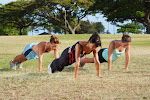 Chocolate Blueberry Energy Bars(this bar is shown at the top of this plate of ingredients, the darker-bluer one of the two)
Chocolate Blueberry Energy Bars(this bar is shown at the top of this plate of ingredients, the darker-bluer one of the two)High in antioxidants and flavonoids, these bars help reduce free radical damage in the body and improve cellular recovery.
Makes approximately (12) 1-3/4 ounce bars
1 cup fresh or soaked dried dates
1/4 cup almonds
1/4 cup blueberries
1/4 cup roasted carob powder (or cacao to make 100% raw) (this was about $8/container)
1/4 cup ground flaxseed (I just used them whole, too lazy to grind)
1/4 cup hemp protein (this was about $19/tub)
1/4 cup unhulled sesame seeds
1 tsp. fresh lemon juice
1/2 tsp lemon zest
sea salt to taste
1/2 cup sprouted or cooked buckwheat (optional, I didn't use)
1/2 cup frozen blueberries
(Sorry! Disregard the banana in this picture, it was used for the next Energy Bar recipe)
(Also, the picture just shows samples of the ingredients, they are not really measured out according to the recipes)
In a food processor, process all ingredients except the buckwheat and blueberries. Knead buckwheat and berries into mixture by hand.
Emily's comments: I only have a blender, so I used this to process instead. Just kept speed on Low and Stir. Also, to form the bars, I scooped (12) small bits into an ice cube tray. Pressed firmly with a narrow spatula. Then let the bars sit for 5 mins. While still wet and soft, I used the narrow spatula to wedge the bars out of the tray, one at a time. It's cool, because they come out in a shape of a triangle. Then I used wax paper to wrap each one.
To store bars: Since these bars are live and raw, store them in the refrigerator or freezer. You can take them on the go with you and the consistency is very soft and moist, but if they are wrapped, they will maintain their triangle shape!
Banana Bread Energy Bars(this one is to the left of the Chocolate Blueberry bar, the lighter-hazel colored of the two)Cinnamon and nutmeg combined with banana give this bar the taste of traditional banana bread, in a healthy, convenient form.
Makes approximately (12) 1-3/4 ounce bars
1 small banana
3/4 cup fresh or soaked dried dates
1/2 cup Popped Amaranth* (not shown, but they look like little cous cous pellets)
1/2 cup walnuts
1/4 cup ground sesame seeds
2 tsp cinnamon
1/2 tsp nutmeg
sea salt to taste
*Popped Amaranth - Light and fluffy, popped amaranth adds texture to energy bars and crunch to salads. Keep refrigerated for up to 2 weeks (because of its natural oils, it needs to be refrigerated)
Use a hot air popcorn popper and pop amaranth as you would corn. You can also you a frying pan: heat a small amount of coconut oil (I used olive, I don't have such specialty oil in my kitchen), just enough to cover the bottom of the pan, over medium heat. Add a small amount of amaranth, just enough to cover the bottom of the pan. As it pops, remove it from the pan with a spatula and add more grains for popping
Emily's comments: I didn't know what the heck Amaranth was, but I found it at Down to Earth, our local health food store in Honolulu. Actually I got all the ingredients, especially the bulk food items, there. I am sure you can find them also at Whole Foods. Anyways, let the amaranth heat and bubble up in the oil for a good 8-9 minutes. I did not know what to look for or expect. I thought each grain might explode like popcorn kernels do, but they didn't. So as they started to turn brown and as I heard tiny popping noises, I turned of the heat and removed them from the pan. It was kinda weird and really makes the bars crunchy. But I figured it's safe to eat since all of these ingredients are raw anyways.
Overall, I really enjoyed making these bars. I did invest in a couple of key ingredients (hemp protein and carob powder), but it was worth it! I spend anywhere between $1.75 - $2.50 for each energy bar I buy at a convenient store.
I have been eating 2-4 each day, and I feel great! I think it's because there is no refined sugars or hydrogenated fats. I've had enough energy to get me through 60 - 90 minutes of working out a day!
Resources: "Thrive: The Vegan Nutrition Guide to Optimal Performance in Sports and Life" by Brendan Brazier
For his book and other recipes: http://www.brendanbrazier.com/book/recipes.html
















